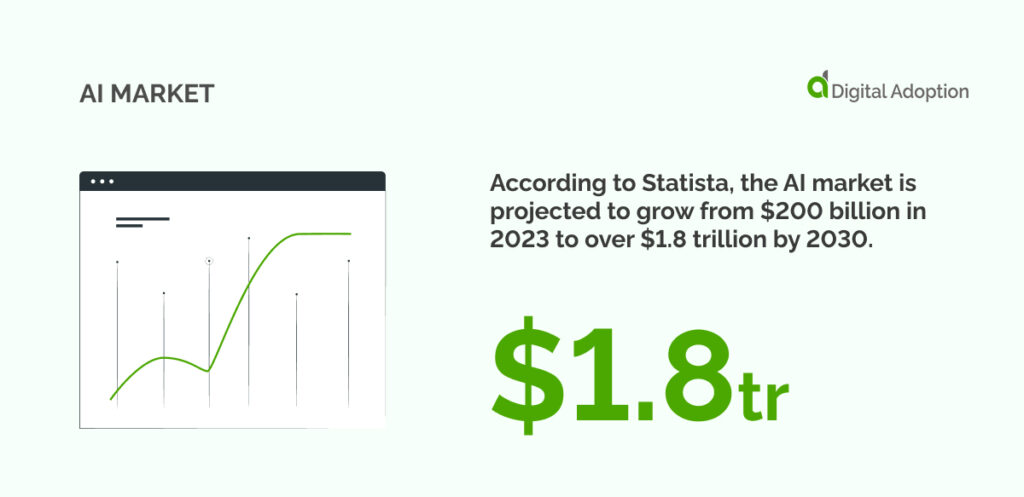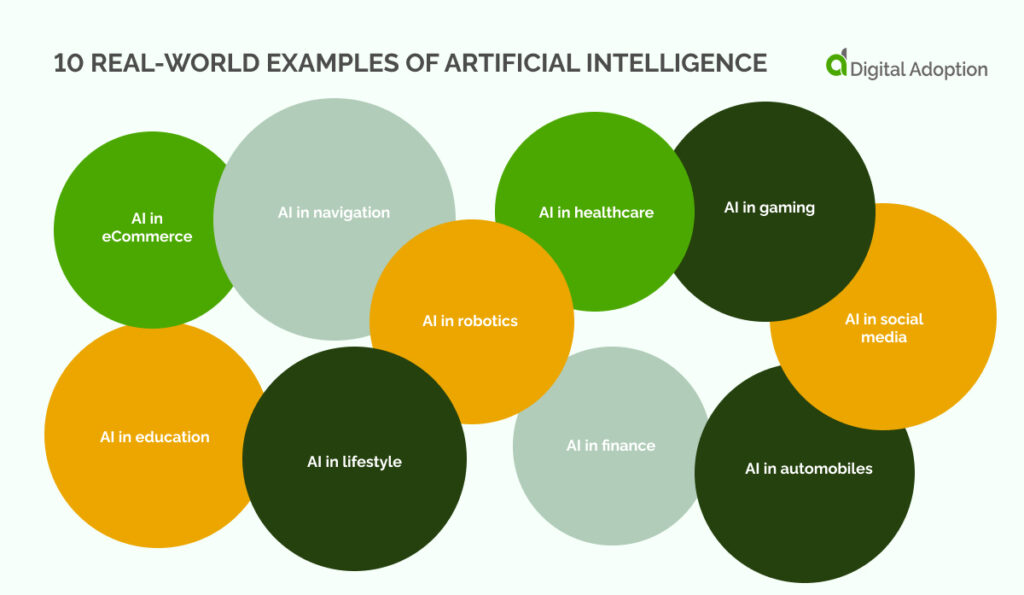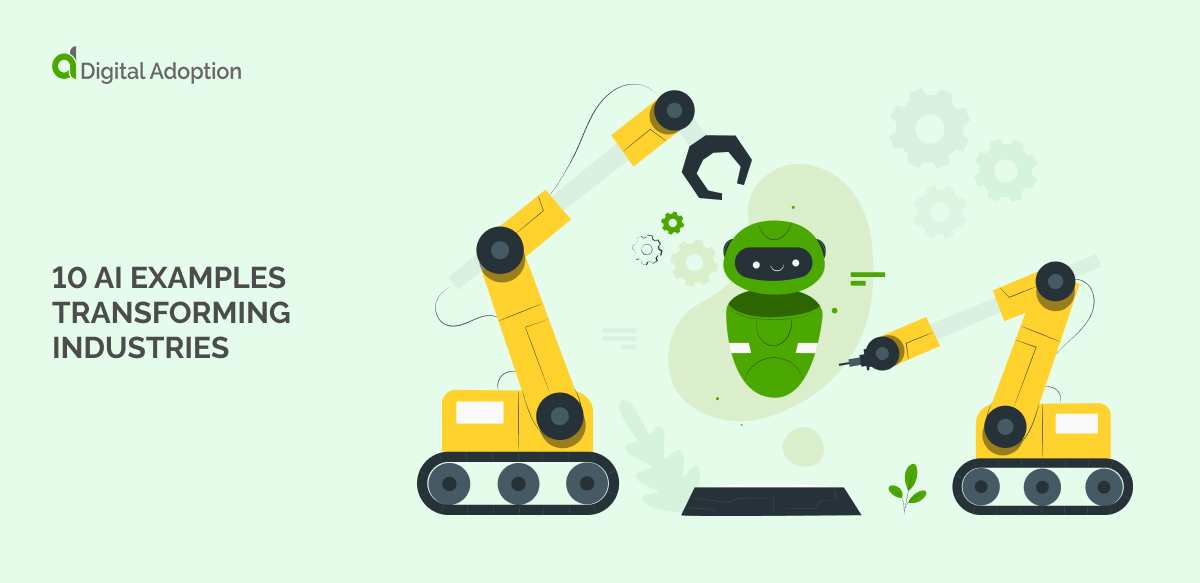AI involves teaching computer systems to complete complex actions like a human would.
It relies on core technologies such as machine learning (ML), deep learning (DL), NLP, and NLU. These technologies create intelligent systems and algorithms that can learn from experience.
Recent advances in AI have sparked widespread interest across business and broader society. The limits of AI show no bounds, with skyrocketing investments continuing industry-wide. According to Statista, the AI market is projected to grow from $200 billion in 2023 to over $1.8 trillion by 2030.

This article explores real-world examples of AI in action. We’ll focus on various ways AI is being used, from small-scale activities to widespread adoption. Then, we’ll look at ten of the most important AI examples in the real world.
10 Real-world examples of artificial intelligence

Artificial intelligence has been around for a while. It’s already garnered mainstream media attention and is evolving at breakneck speed. But are we taking advantage of its full potential?
Understanding AI’s real-world applications and how it’s transforming industries is essential to maximizing the technology’s potential.
To understand AI’s capabilities in the modern world, we’ve broken down the top ten real-world examples of AI by industry.
Let’s explore the top ten examples of AI by industry:
AI in eCommerce
eCommerce is a prime example of AI’s transformative power. From personalized product recommendations to intelligent search, AI streamlines the shopping experience.
It analyzes customer data to predict buying patterns, helping businesses tailor offers and boost sales. AI-powered chatbots provide 24/7 customer support, improving satisfaction.
Even inventory management is optimized with AI, predicting demand and preventing stockouts. AI’s continuous learning and adaptability mean it’s constantly improving. It makes eCommerce smarter, faster, and more customer-centric.
Real-world example
Stitch Fix, an online clothing retailer, heavily relies on AI. Their algorithms analyze a customer’s style quiz, feedback, and purchase history to recommend personalized clothing selections. This data-driven approach elevates the shopping experience and increases customer satisfaction.
AI in education
AI is making inroads into the education sector by offering adaptability and individualization. AI-powered platforms can analyze student data to pinpoint strengths and weaknesses.
This ensures learning resources and practice questions are aligned with their needs. It also helps students learn independently, leading to better engagement and outcomes.
Real-world example
Knewton Alta is an adaptive learning platform used in higher education. It uses AI to customize course materials and assessments based on each student’s performance. This ensures a more personalized and effective learning journey.
AI in lifestyle
AI integrates into our daily lives, offering unparalleled convenience, personalization, and insights. From smart home devices to personalized content recommendations, AI subtly enhances our lifestyle experiences.
AI-powered voice assistants like Alexa allow us to control various home devices with simple voice commands. These assistants can learn our habits to automate tasks and personalize experiences.
Streaming platforms like Netflix and Spotify leverage AI to analyze our preferences. They suggest movies, shows, and music that align with our tastes.
Real-world example
Smart thermostats like Nest use AI to learn your temperature preferences over time. This allows them to create energy-efficient schedules, lowering your bills and reducing your carbon footprint.
AI in navigation
AI is revolutionizing navigation, making travel safer, more efficient, and more accessible. GPS systems use AI to analyze real-time traffic data, predict congestion, and suggest the fastest routes.
Self-driving cars rely on AI-powered systems for object detection, path planning, and decision-making. AI is also improving navigation for those with disabilities. It does this by integrating voice commands and personalized routing options.
Real-world example
Google Maps is a prime example of AI in navigation. It uses machine learning to analyze massive amounts of traffic data. This provides users with accurate travel times, alternative routes, and even warnings about potential slowdowns.
AI in robotics
AI is pushing the boundaries of what robots can do. It transforms them from machines that perform repetitive tasks to intelligent collaborators. AI enables robots to perceive their environment through advanced sensors and computer vision. This allows them to adapt to changes and make decisions in real time.
Machine learning helps robots improve their performance over time and optimize movements. AI also drives advancements in natural language processing, enabling more seamless interactions.
Real-world example
Amazon’s warehouses use thousands of AI-powered robots called “Kiva bots.” These robots use computer vision and machine learning algorithms to navigate the warehouse, retrieve storage pods, and deliver them to human workers for picking and packing. This system has significantly increased efficiency and accuracy in Amazon’s order fulfillment process.
AI in healthcare
AI is poised to revolutionize the healthcare industry, improving diagnosis, treatment, and patient outcomes.
AI-powered systems can analyze vast amounts of medical data, including images like X-rays and MRIs, to detect patterns the human eye might miss. This aids in the early diagnosis of diseases like cancer. AI can also develop personalized treatment plans based on a patient’s medical history, genetics, and other factors.
AI-powered virtual assistants and chatbots can even provide patients with initial triage and support, freeing up medical professionals for more complex cases.
Real-world example
IBM Watson for Oncology is an AI-powered system that assists oncologists in making more informed treatment decisions. It analyzes patient data, medical literature, and clinical guidelines to provide evidence-based recommendations tailored to each case.
AI in gaming
AI is vital in modern game development, leading to more immersive and dynamic gaming experiences.
AI drives the behavior of non-player characters (NPCs), making them more lifelike and unpredictable. They can learn and adapt to player actions, creating a sense of challenge and realism.
AI algorithms can also generate game worlds, levels, and content, ensuring no two playthroughs are identical. They analyze player data to personalize difficulty settings and tailor gameplay experiences.
Real-world example
The game “The Last of Us Part II” features incredibly realistic and adaptive enemy AI. Opponents actively strategize, communicate with each other, flank the player, and react dynamically to environmental changes. This results in incredibly tense and challenging encounters that feel far less scripted than in many similar games.
AI in social media
AI is deeply embedded in the social media landscape, shaping how we interact with content and each other. It plays a significant role in what you see on your feeds. Algorithms analyze your interests, behaviors, and connections to personalize content recommendations.
AI also helps moderate online communities and flag harmful content that violates platform guidelines. AI-powered chatbots can now provide customer service, answer FAQs, and engage directly with users.
Real-world example
TikTok’s Creative Assistant showcases how AI augments social media creation. It analyzes trends, popular formats, and successful content on the platform. This lets the Creative Assistant help users with idea generation, script writing, and tailoring their content for the TikTok audience. This AI-powered tool simplifies the creative process and allows users to produce videos with a better chance of going viral.
AI in finance
AI is revolutionizing the financial industry, enhancing decision-making, improving efficiency, and combating fraud. AI algorithms can analyze vast datasets of financial information to uncover patterns and insights that humans might miss.
AI-powered systems are used to develop credit scoring models that assess risk more accurately. This opens lending opportunities for underserved individuals. AI also drives the creation of high-frequency trading algorithms that execute trades at lightning speed based on real-time market conditions.
Real-world example
Companies like ZestFinance use AI to create alternative credit scoring models. These models analyze non-traditional data points, expanding financial access to those with thin credit histories or past financial difficulties.
AI in automobiles
AI is fast changing how we interact with and experience our cars. Self-driving vehicles heavily rely on AI systems to perceive the environment. They do this through cameras, sensors, and lidar.
These systems use computer vision and machine learning to identify objects, navigate roads, and make real-time driving decisions. AI also enhances assistance features like adaptive cruise control and automatic emergency braking. This makes our roads safer. In-car AI assistants offer voice commands for navigation, music control, and climate settings. This provides a more seamless and intuitive driving experience.
Real-world example
Tesla’s Autopilot is one of the most advanced AI-powered driver systems. It uses a combination of cameras, radar, and ultrasonic sensors, along with powerful neural networks. It can enable features like automatic lane changes, traffic-aware cruise control, and even self-parking capabilities.
AI: The bigger picture
AI’s reach extends far and wide. It’s no longer confined to tech giants–it’s knocking on the door of every sector.
Healthcare professionals are harnessing AI for disease detection. Insurers are using AI to streamline claims processing, predict risk, and even personalize coverage for each individual. In the world of finance, it’s powering lightning-fast trading and robust fraud detection. This is just a taste of how AI is already in play.
Understanding these real-world examples is the secret weapon for navigating the AI revolution. Seeing AI in various industries sparks essential questions: How could this transform my business? Where might I be vulnerable? Is my team prepared for digital transformation?
Studying AI’s successes and failures in other fields gives you the insight needed to plot your unique AI journey. This isn’t guesswork; it’s a calculated strategy to prepare your business to survive the AI wave and ride it confidently to the top.













